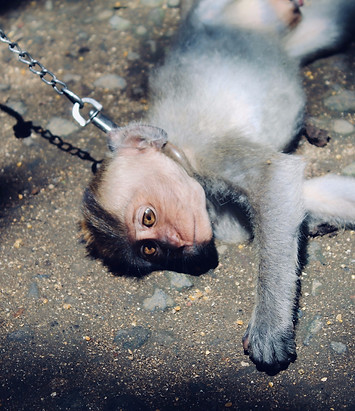
Research
Animal research, testing or experimentation is any scientific test or experiment conducted on living animals for the purposes of science or safety.
What types of animals are
most commonly used?
Dogs

Dogs are frequently bred for the sole purpose of being laboratory subjects, spending their entire, usually short lives locked in cages, being subjected to painful procedures.
The majority of the dogs bred for experimentation, are in fact Beagles, because of their trusting and compliant personalities.
In most cases, dogs provide little or no scientific value.
About 22.967 dogs were reportedly used in research within the EU (2014).
Cats
Thousands of cats used in experiments, are often stray animals coming from shelters.
Cats are highly intelligent beings that suffer from numerous conditions when confined in small cages, including boredom, fear, aggression, and even self-mutilation. Enriching their laboratory environment fails to avoid such problems.
About 3.851 cats were used in research within the EU, in 2014.

Primates

Primates bred used in experiments are separated from their mothers, within three days after birth. They are often also captured in the wild, where wildlife traders pack them in crates and ship them around the world in cargo holds of passenger airlines.
Once in laboratories, these sensitive animals have barely enough space inside their cages and their rich sensory stimulation environment is lost entirely.
Due to confinement, physical abuse, social isolation and psychological stress, about 90% of primates in research exhibit abnormal behaviors including signs of insanity and self-mutilation.
Within the EU in 2014, 8.898 animals were used in research (a 49% - 157% increase depending on species, since 2011).
Rodents
Rodents probably the most abused species in research.
Like all other mammals they too feel pain, fear, stress, loneliness and yet, they are both unprotected by Animal Welfare Laws and excluded from statistical reports or animal testing in countries including the USA and China (the top two contributors in animal experimentation, in 2016).
Adding to this, research has shown that mice and rats, undergoing cruel, invasive procedures, are given post-procedural pain relief only about 20% of the time (Newcastle University, 2009).
They are used in everything from toxicological studies, to psychological tests, experimental surgeries and genetic manipulation experiments.
In 2014, 8.2 million mice, 1.4 million rats, 155.502 guinea pigs, 21.580 hamsters and 54.207 other rodents were used in research within the EU (a total of 9.831.289 animals).


Rabbits
Rabbits are mild-tempered, easy to confine, handle and breed, which makes them frequent victims of animal testing as well.
Rabbits are also used in studies of cardiovascular disease, skin conditions and spinal cord injuries.
About 318.259 rabbits were used in EU research, in 2014.

Pigs
The most common use of pigs in laboratories, involves surgical training exercises in universities and hospitals. Numerous highly intelligent animals are mutilated and killed, to better prepare trainees to treat human patients, even though superior, modern simulation methods, already exist.
In 2014, 72.749 pigs were used in research within the EU.

Fish
Since the 1990's fish have been extensively used in biomedical research, as models of human development and disease, in toxicity testing and in aquaculture research.
The zebrafish is preferred in studies of vertebrate development and physiology as their embryos are transparent, develop outside of the mother's body and grow rapidly.
The exact number of fish used in research is unknown for many countries, such as the US where the species is not protected by the Animal Welfare Act.
In 2014, 1.8 million fish were used in research within the EU.
Birds
(599.185)
Sheep
(60.209)
Goats
(2.655)
EU Statistics 2014


